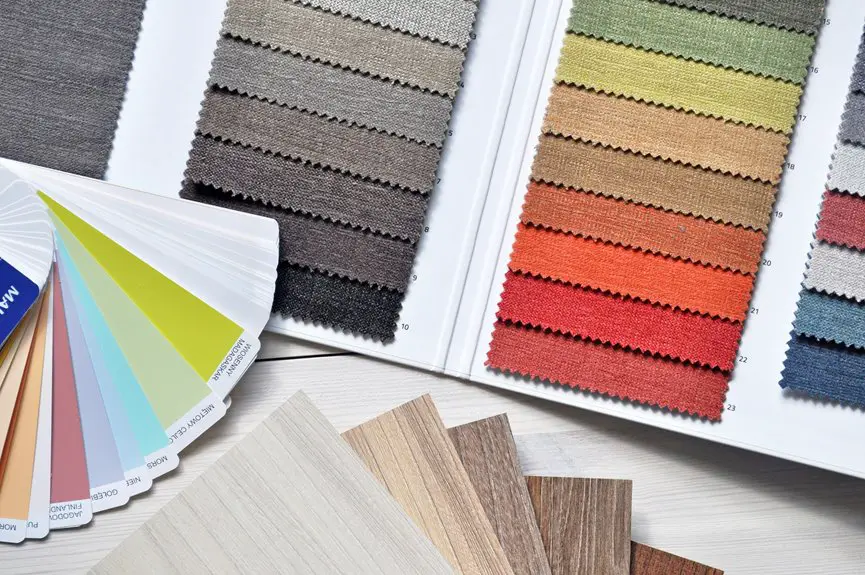You get top-tier flame resistance and durability with Nomex-Kevlar blends, perfect for protective gear. Ripstop fabric offers tough tear resistance with a grid weave, while microfiber blends provide lightweight comfort and moisture-wicking. Both combine Nomex’s heat protection and Kevlar’s strength. Look for reliable suppliers like DuPont with proper certifications to guarantee quality. If you want to choose the best fabric type for your needs and learn where to buy, there’s more helpful info ahead.
Table of Contents
Key Takeaways
- Nomex-Kevlar ripstop blends combine flame resistance with tear-proof grid weave, ideal for durable protective gear in harsh conditions.
- Microfiber blends of Nomex-Kevlar offer lightweight, soft, and moisture-wicking protection suited for comfort-demanding roles like firefighters and military.
- Ripstop fabric is heavier and tougher, while microfiber provides flexibility and breathability without compromising flame resistance.
- Top suppliers include DuPont, offering certified Nomex-Kevlar fabrics with NFPA or ISO compliance and options for samples and customization.
- When purchasing, prioritize certified quality, request samples, compare prices, and seek technical support to ensure suitability and durability.
Understanding the Properties of Nomex and Kevlar
When you look at protective fabrics, Nomex and Kevlar stand out for their unique strengths.
You’ll find Nomex excels in heat and flame resistance, making it ideal for firefighters and industrial workers facing extreme temperatures. It doesn’t melt or drip, which helps prevent severe burns.
Kevlar, on the other hand, is incredibly strong and lightweight, known for its cut and abrasion resistance. You’ll often see it in bulletproof vests, helmets, and other ballistic gear.
Both fibers resist chemicals and wear, but their core benefits differ: Nomex protects you from fire, while Kevlar shields you from physical impacts.
When blended, they offer a versatile fabric that balances heat resistance with durability, perfect for demanding safety applications where you need both qualities.
Key Differences Between Ripstop and Microfiber Fabrics
Although both ripstop and microfiber fabrics serve important roles in protective clothing, they differ markedly in structure and performance.
Ripstop and microfiber each play vital roles in protective clothing, differing significantly in structure and function.
When choosing between them, you should consider these key differences:
- Weave Pattern: Ripstop features a grid-like weave that prevents tears from spreading, while microfiber has a smooth, tightly woven texture for softness.
- Durability: Ripstop offers superior tear resistance, ideal for rough environments; microfiber prioritizes comfort and breathability.
- Weight: Ripstop tends to be heavier due to its reinforced threads, whereas microfiber is lightweight and flexible.
- Applications: Ripstop suits high-abrasion settings like firefighting gear; microfiber is often used where moisture-wicking and comfort matter, such as in base layers.
Understanding these distinctions helps you pick the right fabric for your specific protective needs.
Advantages of Using Nomex-Kevlar Ripstop Blends
Ripstop fabrics stand out for their durability, but combining Nomex and Kevlar takes their performance to the next level. When you use Nomex-Kevlar ripstop blends, you get enhanced flame resistance alongside exceptional tear strength. This blend also offers excellent abrasion resistance, making it ideal for tough environments. You’ll appreciate how the fabric maintains flexibility, ensuring comfort without sacrificing protection.
| Feature | Benefit | Why It Matters |
|---|---|---|
| Flame Resistance | Protects against heat | Keeps you safe in high-heat work |
| Tear Strength | Resists ripping | Extends garment lifespan |
| Abrasion Resistance | Withstands rough surfaces | Maintains integrity over time |
Choosing Nomex-Kevlar ripstop means you get durable, protective gear that doesn’t hinder movement.
Benefits of Nomex-Kevlar Microfiber Blends in Protective Gear
Three key benefits make Nomex-Kevlar microfiber blends a top choice for protective gear.
When you choose this fabric, you get superior flame resistance, combining Nomex’s heat protection with Kevlar’s strength. It also offers exceptional comfort thanks to its lightweight and breathable microfiber structure.
Plus, durability is outstanding, letting your gear endure harsh conditions longer without compromising safety.
Here’s why you’ll appreciate Nomex-Kevlar microfiber blends:
- Enhanced thermal protection against flames and heat.
- Lightweight feel that doesn’t weigh you down.
- Increased durability for extended gear lifespan.
- Improved moisture-wicking to keep you dry and comfortable.
These benefits make this blend ideal for firefighters, military personnel, and anyone needing reliable, comfortable protective clothing.
Top Suppliers and Tips for Purchasing Nomex-Kevlar Fabrics
Finding reliable suppliers for Nomex-Kevlar fabrics is essential to guarantee you get high-quality materials that meet safety standards.
Look for well-established manufacturers like DuPont or trusted distributors specializing in protective textiles. Check for certifications such as NFPA or ISO compliance to verify authenticity. Always request material samples before committing to large orders.
Compare prices but don’t compromise quality for cost—protective gear depends on fabric performance. Also, ask about minimum order quantities, delivery times, and return policies.
Online reviews and industry forums can provide insight into supplier reliability. Finally, consider suppliers who offer technical support or customization options to match your specific needs.
Frequently Asked Questions
Can Nomex-Kevlar Blends Be Dyed Without Compromising Their Integrity?
You can’t dye Nomex-Kevlar blends without risking their integrity. The fibers’ heat and flame-resistant properties might degrade during dyeing, so it’s best to choose pre-colored fabrics or specialized treatments that maintain their protective qualities.
How Do Nomex-Kevlar Fabrics Perform Against Chemical Exposure?
You won’t believe how tough Nomex-Kevlar fabrics are against chemicals! They resist many hazardous substances, protecting you like a superhero’s armor, but remember, some strong acids or solvents can still weaken their fibers over time.
What Is the Environmental Impact of Producing Nomex-Kevlar Blends?
You’ll find that producing Nomex-Kevlar blends consumes significant energy and water, with chemical usage impacting the environment. However, their durability reduces waste by extending product life, balancing some environmental concerns in the long run.
Are There Specific Care Instructions to Extend the Life of Nomex-Kevlar Gear?
Don’t treat your gear like everyday clothes; you’ll shorten its life. Always wash with mild detergent, avoid bleach, and air dry. Store it away from direct sunlight and heat to keep its protective qualities intact.
Can Nomex-Kevlar Blends Be Recycled or Repurposed After Use?
You can’t easily recycle Nomex-Kevlar blends because of their complex fibers, but you can repurpose worn gear for padding or insulation. Try donating to organizations that accept used protective gear for creative reuse projects.
- Stretch Nomex Fabric: Flexibility Meets Fire Resistance - June 22, 2025
- Is Nomex Fabric Waterproof? The Truth About Its Water Resistance - June 22, 2025
- Nomex in Action: Key Applications From Riding Gear to Gaskets - June 22, 2025







